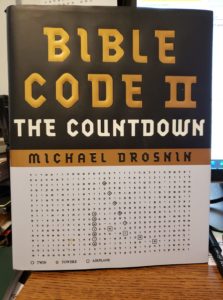
Having finished reading another book aloud (which I haven’t reviewed yet, but will), I suggested to Lynda that we next read Bible Code II. I did this because we had read Bible Code 1 years ago, the sequel was sitting next to it, and I thought we could read the second and put both out for sale or donation. She agreed, and we read it.
The author, Michael Drosnin, has taken the computer work of Israeli mathematician Dr. Eliyahu Rips and written popular books about a hidden code in the Hebrew version of the Bible. The first book dealt with codes in the Torah, the first five books of the Old Testament, also called the books of Moses. The second book extends into the entire Old Testament. In the first book, Drosnin explained that the Hebrew text of the Torah as settled. No one disputed the exact arrangement of letters and words. However, as he explained in BC:2, that isn’t the case with the rest of the Old Testament. Some Hebrew text is disputed.
How does the code in the Bible work? You skip letters on a fixed pattern and see what results. Skip every other letter. Do the letters then brought together form a word? No? Skip two consecutive letters, putting every third letter together instead of every other. Maybe those, somewhere in the continuous string of letters that make up the O.T., form words of phrases. Sometimes you look for the words forwards in the text, sometimes backwards, sometimes diagonally.
With hundred of thousands of words and even more letters, you have an almost infinite number of possible skip patterns, you have many, many places to look for encoded words. Isaac Newton was convinced such a code and spent years trying to find it. Dr. Rips, however, had computers. He figured out how to put the skip pattern in a table, then search the table for recognizable words. He found many such words, words that seemed to predict world events long after the Bible was written. In Bible Code 1 Drosnin described the process. In Bible Code II he expanded on it. As a control, they tried the same thing with other books of a similar lengths, and learned that these books did not form words or phrases in similar skip patterns in any meaningful way.
The conclusion: The Hebrew Old Testament contains a code that predicts future events. Who wrote the code? To the secular Drosnin that is unknown. To the devout Dr. Rips it had to be God.
The problem is that most events found in the code are found after the event happened. G.W. Bush is elected president? Break out your computer, search for “Bush” with an infinite number of skip patterns and you’ll find it. A few times, however, an event was found before it happened. The code seemed to predict the assassination of Israeli Prime Minister Yitzhak Rabin in 1995, and was found in 1994 and communicated to Rabin. The assassination happened—in 1995.
In the Bible Code 2, published in 2002, six years after the first book, the main premise is that a nuclear holocaust was going to happen; it would start in Jerusalem and result in annihilation of the Israelis and the Palestinians. Like other coded events, it was tied to a year, in this case 2006.
Yes, 2006. Fourteen years ago. A major part of the book was a warning that we must somehow prevent this from happening. In 2002 world conditions looked awful. Iran was angling to get the bomb. The Palestinians were in the midst of the second Intifada and Israel was aggressively resisting. The 9/11 attacks were fresh on everyone’s mind. We seemed to be in the age of terrorism in a new way.
Yet, no nuclear holocaust occurred in 2006, of in 2007, or in 2008, or any year since.
Is the Bible code real? I have no idea and have no way of judging if Rips and Drosnin are doing something valuable of are engaged in a well-meaning smoke-and-mirrors error. I do know that Drosnin’s work receives lots of criticism.
Should you buy the book and use your valuable time reading it? Probably not. It’s somewhat boring and quite repetitive. It’s actually a quick read since much of the book is diagrams of the code, in Hebrew with English translations. I intend to do a little investigation from my reading chair and see what these gentlemen have said in the intervening years. And see what others are saying about the Bible code and its validity. If there is a Bible Code III, however, I for sure won’t be reading it.
If you want to look at this further, Wikipedia has an excellent article on the Bible code.